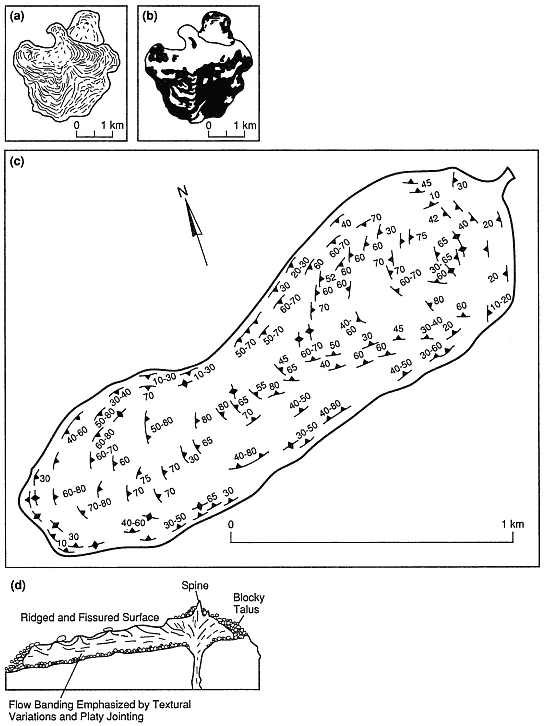Lava Flows and Domes
For lava flows and domes, descriptions should include observations of texture, flow layering, jointing. petrology, overall lava flow type, thermal effects, and thickness. The field geologist also samples representative lava units.
Texture
Textural variations that might be found within flows or domes include differences in vesicularity (size, shape, and orientation), phenocryst content and size, brecciation, and flow foliation or layering. Coarsely pumiceous zones, which have risen diapirically and may have been broken or folded by flow movement (Fink and Manley, 1987), are often distinct features that can be mapped. Variations in relief and vesicularity may be visible on aerial photographs of silicic lava flows and can be used to map flow structures (Fig. A.6).
Flow Layering
Especially in lavas of intermediate to silicic compositions, layering is common and ranges from submicrometer shears to macroscopic bands of dense glass and slightly vesicular glass. Layering attitudes, measured vertically and over the entire lava flow, can provide information about vent locations and the physical properties of the flow.
Jointing
Most lavas are broken into blocks by thermal stresses during cooling. The open fractures or joints are often columnar and form at right angles to the flow surface and base (normal to the isotherms or cooling surfaces). Fracture surfaces are striated; Ryan and Sammis (1978) concluded that striae provide a record of incremental crack advance during stress buildup in the cooling lava (Fig. A.7).
Columnar joints can range from a few tens of centimeters to >1 m wide and can be up to 30 m long in some thick plateau basalt flows. The columns can have as few as three or as

Fig. A.6
Examples of maps and useful observations of silicic lava flows. (a) Sketch map of Little
Glass Mountain in California, made quickly from an aerial photograph. This is a young rhyolitic
obsidian flow for which flow lobes and the direction of flow can be observed by mapping
the ridged and furrowed flow surface; from this information and topographic profiles,
it is possible to locate the vent area. The flow lobes also can be identified through
textural changes; in this example, zones of coarsely vesicular pumice can be mapped.
(Adapted from Fink and Manley, 1987.) (b) Map of Little Glass Mountain that shows
zones of coarsely vesicular pumice (dark areas). (Adapted from Fink and Manley, 1987).
(c) Map of the Watchman dacite flow at Crater Lake in Oregon. Flow patterns
were identified by measuring the attitudes of flow foliation. This method is particularly
useful if no aerial photographs are available. (Adapted from Williams, 1942). (d) Cross
section along the long axis of a silicic lava flow illustrates textural variations, including
coarse rubble scattered over the flow surface, along the flow front, and at the base.
Ragged spines or slabs quite often extend out from the flow or dome.
many as seven sides; most appear to have five or six sides (Williams and McBirney, 1979). Maps of column orientations can sometimes help determine lava flow boundaries, and this is especially useful where outcrops are poor. For example, within a valley-filling lava flow, columns in the center of the valley would be vertical; however, along the valley walls, they would be oriented at an angle and would be perpendicular to the walls, which had acted as heat sinks during cooling of the lava flow. Similar columnar jointing can also be found in dikes, plugs, and lava lakes.
If the lavas are potential reservoir rocks, maps of the size, width, and extent of cooling joints in these flows exposed at the surface may be useful for estimating their permeability.
Petrology
For field identification of lava type, geologists use the petrographic classification with which they are most familiar (such as those illustrated in Fig. 1.3 and Appendix B, for instance), but consistency is crucial. The field descriptions should be the best possible, but it is likely that these will change after thin sections have been examined petrographically, especially in the case of finely crystalline rocks.
Lava Flow Type
If possible, descriptions of the type of lava flow should include its overall texture and morphology. Most basaltic lavas can be identified by the terms pahoehoe, aa , or block lava . Details of basal breccia and lava tubes or channels should be provided if they are visible.
Thermal Effects
To ascertain whether there has been thermal alteration of rocks underlying the lava flow, field geologists look for oxidation of soil layers or older rocks, formation of pipe vesicles during heating of water in soil or bogs, and desiccation of clastic sedimentary rocks (Fig. A.7).
Thickness
In measuring thicknesses, all mappable sub-divisions (eruption unit, member, or formation) and all textural subunits are noted.

Fig. A.7
Cross section of a generic basaltic lava flow, showing some of the basic structural features
that should be described when mapping flows. Flow surfaces, if preserved, present
a variety of textures that range from smooth, ropy pahoehoe to spiny, rubbly aa lavas.
Flow interiors exhibit variations in structure such as different types of columnar joints,
vesicle concentrations, and lava tubes; the presence of these features often depends
on flow thickness and viscosity. Pipe vesicles are formed within flows as they cross
wet ground; rising steam leaves vesicle trains or small tubes that are bent by flow
(a good indicator of flow direction). Lava blocks spalled or extruded from the toe of
an aa lava flow leave lava rubble beneath and in front of the flow.
Thickness is measured from the base of a unit to the level of some significant textural change.
Sampling
Lava samples are critical for developing a sound understanding of the time-stratigraphy for a field area. In addition to providing documentation of the petrogenetic evolution of a volcanic field, carefully selected samples can provide important radiometric dates. To obtain dates and chemical analyses that are reliable, it is important to assess the evident weathering and diagenetic effects as well as phenocryst content of samples.